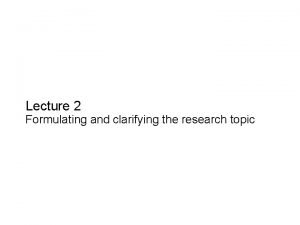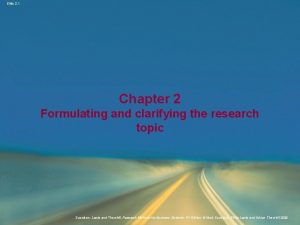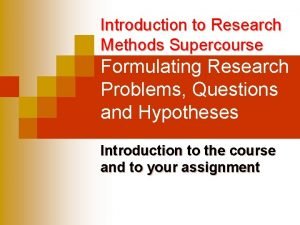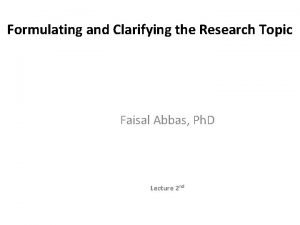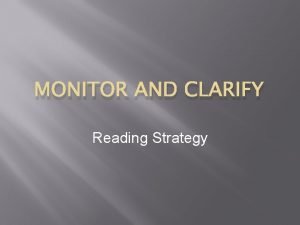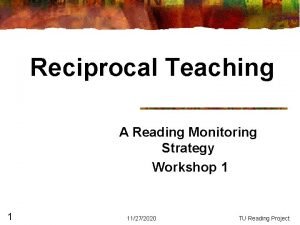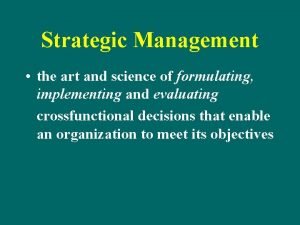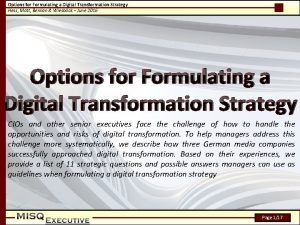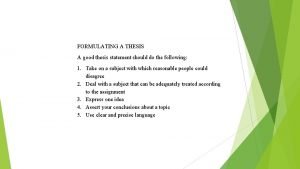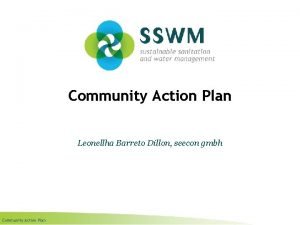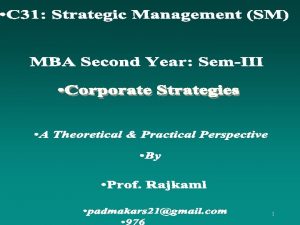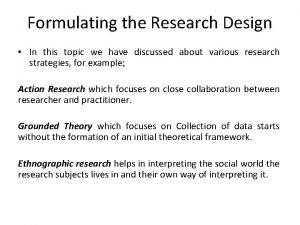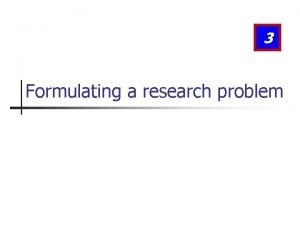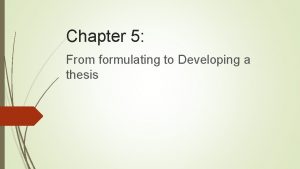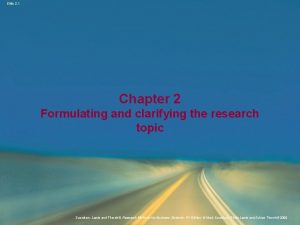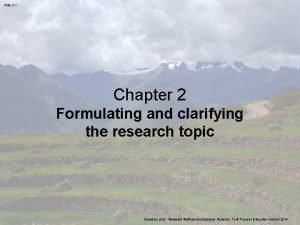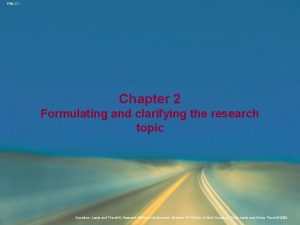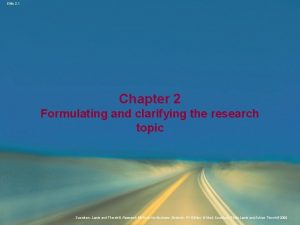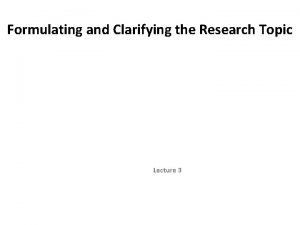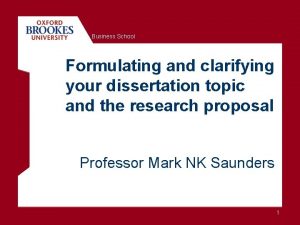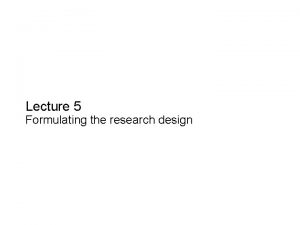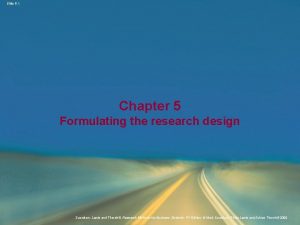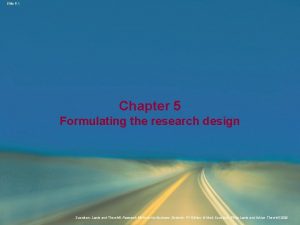Slide 2 1 Lecture 2 Formulating and clarifying
























- Slides: 24

Slide 2. 1 Lecture 2 Formulating and clarifying the research topic Saunders, Lewis and Thornhill, Research Methods for Business Students , 5 th Edition, © Mark Saunders, Philip Lewis and Adrian Thornhill 2009

Slide 2. 2 Formulating and clarifying your research topic The important steps • Identifying the attributes of a good research topic • Generating ideas that help you select a suitable topic • Turning ideas into clear research questions and objectives • Writing your research proposal Saunders, Lewis and Thornhill, Research Methods for Business Students , 5 th Edition, © Mark Saunders, Philip Lewis and Adrian Thornhill 2009

Slide 2. 3 Attributes of a good research topic (1) Capability: is it feasible? • Are you fascinated by the topic? • Do you have the necessary research skills? • Can you complete the project in the time available? • Will the research still be current when you finish? • Do you have sufficient financial and other resources? • Will you be able to gain access to data? Saunders, Lewis and Thornhill, Research Methods for Business Students , 5 th Edition, © Mark Saunders, Philip Lewis and Adrian Thornhill 2009

Slide 2. 4 Attributes of a good research topic (2) Appropriateness: is it worthwhile? • Will the examining institute's standards be met? • Does the topic contain issues with clear links to theory? • Are the research questions and objectives clearly stated? • Will the proposed research provide fresh insights into the topic? • Are the findings likely to be symmetrical? • Does the research topic match your career goals? Saunders, Lewis and Thornhill, Research Methods for Business Students , 5 th Edition, © Mark Saunders, Philip Lewis and Adrian Thornhill 2009

Slide 2. 5 Attributes of a good research topic (3) And - (if relevant) Does the topic relate clearly to an idea you were given possibly by your organisation ? Saunders, Lewis and Thornhill, Research Methods for Business Students , 5 th Edition, © Mark Saunders, Philip Lewis and Adrian Thornhill 2009

Slide 2. 6 Generating research ideas Useful Techniques Rational thinking Creative thinking • Examining your own strength and interests • Examining staff research interests • Looking at past project titles • Discussions • Searching the literatures • Canning the media • Keeping a notebook of your ideas • Exploring personal preferences using past projects • Exploring relevance to business using the literature • Relevance tree • brainstorming Saunders, Lewis and Thornhill, Research Methods for Business Students , 5 th Edition, © Mark Saunders, Philip Lewis and Adrian Thornhill 2009

Slide 2. 7 Relevance Tree Saunders, Lewis and Thornhill, Research Methods for Business Students , 5 th Edition, © Mark Saunders, Philip Lewis and Adrian Thornhill 2009

Slide 2. 8 Relevance Tree Saunders, Lewis and Thornhill, Research Methods for Business Students , 5 th Edition, © Mark Saunders, Philip Lewis and Adrian Thornhill 2009

Slide 2. 9 Refining research ideas • Using the Delphi Technique • Conducting a preliminary study • Continually testing out your ideas • Integrating ideas • Refining topics given to you by your organisation Saunders, Lewis and Thornhill, Research Methods for Business Students , 5 th Edition, © Mark Saunders, Philip Lewis and Adrian Thornhill 2009

Slide 2. 10 More frequently used techniques for generating and refining research ideas • Rational thinking • Examining your own strengths - It is important that you choose a topic in which you are likely to do well and, if possible, already have some academic knowledge. • Looking at past project titles - A common way of doing this is to scan a list of past project titles for anything that captures your imagination. • Discussion - Colleagues, friends and university tutors are all good sources of possible project ideas. • Searching the literature - These include reading articles in academic and professional journals; reports; or books. • Creative thinking • Keeping a notebook of ideas and interests - All this involves is simply noting down any interesting research ideas as you think of them and, of equal importance, what sparked off your thought. • Exploring personal preferences using past projects -Select few projects that you like, note down your first thoughts, What appeals to you about the project, What is good about the project, Why is the project good etc. • Relevance trees - you start with a broad concept from which you generate further (usually more specific) topics • Brainstorming - a problem-solving technique on many business and management courses, can also be used to generate and refine research ideas. Saunders, Lewis and Thornhill, Research Methods for Business Students , 5 th Edition, © Mark Saunders, Philip Lewis and Adrian Thornhill 2009

Slide 2. 11 Writing research questions Write research questions that are • Consistent with expected standards • Able to produce clear conclusions • At the right level ( not too difficult ) • Not too descriptive • Use the ‘Goldilocks Test’ : too big, too small, too hot, just right Clough and Nutbrown (2002) Saunders, Lewis and Thornhill, Research Methods for Business Students , 5 th Edition, © Mark Saunders, Philip Lewis and Adrian Thornhill 2009

Slide 2. 12 Turning ideas into research projects (1) Examples of research ideas and their derived focus questions Table 2. 2 Examples of research ideas and their derived focus research questions Saunders, Lewis and Thornhill, Research Methods for Business Students , 5 th Edition, © Mark Saunders, Philip Lewis and Adrian Thornhill 2009

Slide 2. 13 Turning ideas into research projects (2) Useful techniques • Start with a general focus question • Use the ‘Russian Doll’ principle to reach the essence of the question • Discuss areas of interest with your tutor Saunders, Lewis and Thornhill, Research Methods for Business Students , 5 th Edition, © Mark Saunders, Philip Lewis and Adrian Thornhill 2009

Slide 2. 14 Turning ideas into research projects (3) Writing clear research objectives • Check your examining body’s preferences for stated objectives • Use a general focus question to achieve precise objectives Saunders et al. (2009) Saunders, Lewis and Thornhill, Research Methods for Business Students , 5 th Edition, © Mark Saunders, Philip Lewis and Adrian Thornhill 2009

Slide 2. 15 Turning ideas into research projects (4) Include SMART Personal objectives S pecific M easurable A chievable R ealistic T imely Saunders, Lewis and Thornhill, Research Methods for Business Students , 5 th Edition, © Mark Saunders, Philip Lewis and Adrian Thornhill 2009

Slide 2. 16 The importance of theory • Asking for opinions and gathering facts – 'what' questions (descriptive research) • Using questions that go beyond description and require analysis – 'why' questions Phillips and Pugh (2005) In order to: Explain phenomena Analyse relationships Predict outcomes Compare and generalise Saunders, Lewis and Thornhill, Research Methods for Business Students , 5 th Edition, © Mark Saunders, Philip Lewis and Adrian Thornhill 2009

Slide 2. 17 Threefold typology of theories Grand, middle range and substantive theories Creswell (2002) Figure 2. 1 Grand, middle-range and substantive theories Saunders, Lewis and Thornhill, Research Methods for Business Students , 5 th Edition, © Mark Saunders, Philip Lewis and Adrian Thornhill 2009

Slide 2. 18 Writing your research proposal Purposes of the research proposal • To organise your ideas • To convince your audience • To contract with your client (your tutor or commercial client) • To meet ethical requirements Saunders, Lewis and Thornhill, Research Methods for Business Students , 5 th Edition, © Mark Saunders, Philip Lewis and Adrian Thornhill 2009

Slide 2. 19 Content of your research proposal (1) • Title - likely to change during the process • Background - context within the literature • Research questions and objectives - what you seek to achieve Saunders, Lewis and Thornhill, Research Methods for Business Students , 5 th Edition, © Mark Saunders, Philip Lewis and Adrian Thornhill 2009

Slide 2. 20 Content of your research proposal (2) • Method - can be in two parts: research design and data collection • Timescale and Resources - (finance, data access, equipment) • References - include some key literature sources Saunders, Lewis and Thornhill, Research Methods for Business Students , 5 th Edition, © Mark Saunders, Philip Lewis and Adrian Thornhill 2009

Slide 2. 21 Gantt chart to illustrate Timescale of your research project (just an example) Saunders, Lewis and Thornhill, Research Methods for Business Students , 5 th Edition, © Mark Saunders, Philip Lewis and Adrian Thornhill 2009

Slide 2. 22 Evaluating research proposals • How the components of the proposal fit together • Viability of the proposal • Absence of preconceived ideas Saunders, Lewis and Thornhill, Research Methods for Business Students , 5 th Edition, © Mark Saunders, Philip Lewis and Adrian Thornhill 2009

Slide 2. 23 PROGRESSING YOUR RESEARCH PROJECT From research ideas to a research proposal • If you have not been given a research idea, consider the techniques available for generating and refining research ideas. Choose a selection of those with which you feel most comfortable, making sure to include both rational and creative thinking techniques. Use these to try to generate a research idea or ideas. • Evaluate your research ideas • Refine your research ideas using a selection of the techniques available for generating and refining research ideas. • Use your research idea to write a general focus research question. Where possible this should be a ‘why? ’ or a ‘how? ’ rather than a ‘what? ’ question • Use the general focus research question to write more detailed research questions and your research objectives. Saunders, Lewis and Thornhill, Research Methods for Business Students , 5 th Edition, © Mark Saunders, Philip Lewis and Adrian Thornhill 2009

Slide 2. 24 PROGRESSING YOUR RESEARCH PROJECT From research ideas to a research proposal • Write your research proposal making sure it includes a clear title and sections on: • • • the background to your research; your research questions and objectives; the method you intend to use; the timescale for your research; the resources you require; references to any literature to which you have referred. Saunders, Lewis and Thornhill, Research Methods for Business Students , 5 th Edition, © Mark Saunders, Philip Lewis and Adrian Thornhill 2009
 How to write objectives of research
How to write objectives of research Formulating and clarifying the research topic
Formulating and clarifying the research topic Formulating and clarifying the research topic
Formulating and clarifying the research topic Formulating and clarifying the research topic
Formulating and clarifying the research topic Directional and non directional hypothesis
Directional and non directional hypothesis Formulating and clarifying the research topic
Formulating and clarifying the research topic What are the basic dance steps in heel and toe polka
What are the basic dance steps in heel and toe polka Roles and responsibilities slide
Roles and responsibilities slide 01:640:244 lecture notes - lecture 15: plat, idah, farad
01:640:244 lecture notes - lecture 15: plat, idah, farad Spellers clarifying phrase
Spellers clarifying phrase Active listening is focused and purposeful
Active listening is focused and purposeful Clarifying the research question
Clarifying the research question Clarify reading strategy
Clarify reading strategy Clarifying for comprehension dialogue example
Clarifying for comprehension dialogue example What can be defined as the art and science of formulating
What can be defined as the art and science of formulating Options for formulating a digital transformation strategy
Options for formulating a digital transformation strategy Formulating a thesis
Formulating a thesis Community action plan
Community action plan Formulating corporate level strategy
Formulating corporate level strategy Formulating a research design
Formulating a research design Claim/thesis definition
Claim/thesis definition Considerations in selecting a research problem
Considerations in selecting a research problem Unit 1 materials formulating matter
Unit 1 materials formulating matter What is the objective of the imdg?
What is the objective of the imdg? Formulating thesis statement
Formulating thesis statement

